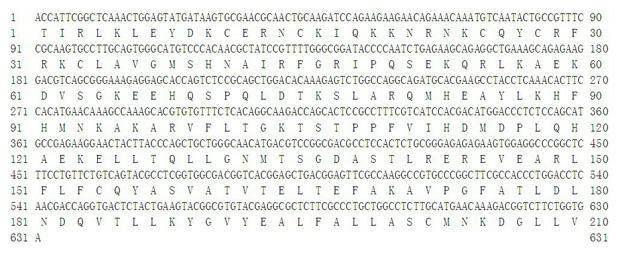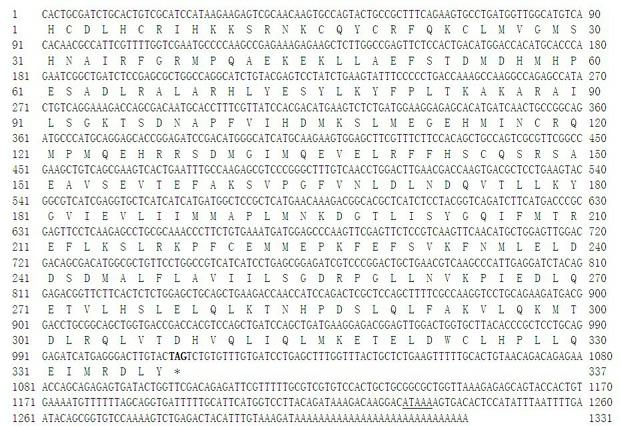Inducer for activating expression of fish lipid metabolism control gene and application thereof
A technology for regulating genes and inducers, applied in the field of biotechnology applications, can solve the problems of slow growth, abnormal body shape, and reduce the quality and flavor of fish meat, and achieve the effects of improving meat quality and reducing fat deposition.
- Summary
- Abstract
- Description
- Claims
- Application Information
AI Technical Summary
Problems solved by technology
Method used
Image
Examples
Embodiment 1
[0043] Example 1 The successful cloning of the new cDNA sequence of grass carp peroxisome proliferator-activated receptor gene
[0044] Grass carp was provided by Guangdong Famous Freshwater Fish Breeding Center (Panyu, Guangdong).
[0045] (1) Total RNA extraction and first-strand cDNA synthesis
[0046] Liver tissue was quickly isolated from grass carp, and total RNA was extracted and purified according to the method recommended by Promega's SV Total RNA Isolation System kit. The first strand of cDNA was synthesized using the ReverTra Ace-α-TM kit from TOYOBO, with grass carp liver total RNA as the template and oligo (dT)20 as the reverse transcription primer, and the operation was carried out according to the method recommended by the kit.
[0047] (2) Cloning of the cDNA core sequence of grass carp PPAR gene
[0048] Three pairs of degenerate primers PPARα01F and PPARα02R, PPARβ01F and PPARβ02R, PPARγ01F and PPARγ02R were designed and synthesized based on the conserved r...
Embodiment 2
[0054] Example 2 Study on tissue expression of grass carp PPARα, PPARβ and PPARγ genes
[0055] Using β-actin as an external reference, the relative expression levels of PPARα, PPARβ and PPARγ gene mRNA in grass carp liver, brain, spleen, muscle, fat and heart were compared by fluorescent quantitative PCR method, with 5 records in each group. Specific primers FQPPARα01F and FQPPARα02R, FQPPARβ01F and FQPPARβ02R, FQPPARγ01F and FQPPARγ02R were designed according to the cDNA core sequences of grass carp PPARα, PPARβ and PPARγ genes (Table 1), and the PCR product fragment sizes were 202 bp, 185 bp and 206 bp, respectively. Specific primers FQACT01F and FQACT02R were designed for β-actin (Table 1). The PCR reaction conditions were 94 °C pre-denaturation for 3 min, 94 °C for 1 min, 57 °C for 1 min, 72 °C for 1 min, a total of 30 cycles, and the final cycle at 72 °C Extend for 5 min. For the PPAR / beta-actin mRNA (%) data of grass carp liver, brain, spleen, muscle, fat and heart, ple...
Embodiment 3
[0056] Example 3 The effect of intraperitoneal injection of different concentrations of inducers on the expression of PPAR gene in grass carp
[0057] Grass carp are raised in aquariums with constant flow of filtered water, and rationed daily from 10:00 to 11:00 with floating pellets of 2% of the fish’s body weight (Guangzhou Haiwei), collected at 11:00-12:00 Remaining feed, 7 days before the experiment, re-weighed, and grouped fish with similar body weight into one group, with 5 fish in each group, for the injection test. The inducer Clofibrate (clofibrate) was dissolved in dimethylsulfoxide, 2-bromo palmitate (2-bromopalmitate), 15-deoxy-Δ12,14-prostaglandin J2 (15-deoxy-Δ12,14-prostaglandin Primer J2) was dissolved in absolute ethanol. Phosphate buffer PBS was used as the diluent, and the inducer was diluted to the corresponding concentration. After feeding once at 10:00-11:00, the anesthesia injection was started. The control group was only injected with 200ulPBS, and th...
PUM
 Login to View More
Login to View More Abstract
Description
Claims
Application Information
 Login to View More
Login to View More - R&D
- Intellectual Property
- Life Sciences
- Materials
- Tech Scout
- Unparalleled Data Quality
- Higher Quality Content
- 60% Fewer Hallucinations
Browse by: Latest US Patents, China's latest patents, Technical Efficacy Thesaurus, Application Domain, Technology Topic, Popular Technical Reports.
© 2025 PatSnap. All rights reserved.Legal|Privacy policy|Modern Slavery Act Transparency Statement|Sitemap|About US| Contact US: help@patsnap.com



